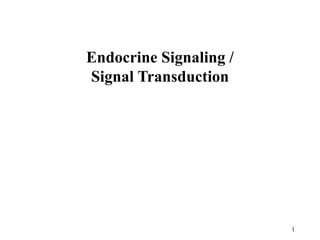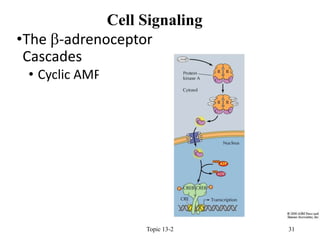Endocrine Signaling.ppt
- 1. 1 Endocrine Signaling / Signal Transduction
- 2. •The Insulin Receptor Cascades Topic 13-2 2 Cell Signaling Insulin Receptor IRS-1 P Y Y Y Y Y Y PI-3 kinase Insulin IRS-x P P P MAPK P P
- 3. •The Insulin Receptor Cascades • Ras • ras gene - originally discovered as a viral oncogene •Also part of the normal genome •Many tumor cells contain a mutant ras •Protein product Ras • Small G-protein • At inner surface of plasma membrane • Lipid group embedded in inner leaflet •Forms an important link to nucleus via mitogen activated protein kinases (MAPK) Topic 13-2 3 Cell Signaling
- 4. •The Insulin Receptor Cascades • MAPK •Best characterized group – extracellular signal- regulated kinase (ERK) family •Act via either of two pathways: • RTKs such as the insulin cascade • Also via G-protein coupled receptors •ERK activation via coupling to • Ras and • Raf a protein serine/threonine kinase Topic 13-2 4 Cell Signaling
- 5. •The Insulin Receptor Cascades • Ras Raf and MAPK Topic 13-2 5 Cell Signaling Insulin
- 6. •The Insulin Receptor Cascades • Ras Raf and MAPK Topic 13-2 6 Grb-2 Cell Signaling IRS-1 P Insulin Receptor Y Y Y Y Y Y Insulin P P SH2 domain GTP test SOS (is a GEF) GDP
- 7. • The Insulin Receptor Cascades • Raf recruitment • Raf then phosphorylates MAPK/ERK kinase known as MEK • MEK has dual specificity – phosphorylates • Threonine • Tyrosine • These are separated by one aa residue • Example ERK2 – Thr 183 and Tyr 185 • Downstream effects of ERK - transcription Topic 13-2 7 Cell Signaling
- 8. •The Insulin Receptor Cascades •Mechanism of Ras activation •Mediated by guanine nucleotide exchange factors (GEF) • Stimulate release of bound GDP • Exchange for GTP •Activation of Ras-GTP terminated by GTP hydrolysis • GTPase-activating proteins interact and accelerate GTP hydrolysis Topic 13-2 8 Cell Signaling
- 9. •The Insulin Receptor Cascades •Mechanism of Ras activation Topic 13-2 9 Cell Signaling
- 10. •The Insulin Receptor Cascades •Ras activation •A well characterized GEF is Sos •Sos is bound to Grb2 • Found in the cytosol •Grb2 is an adaptor protein • Has no other intrinsic activity • Has SH2 domain – high affinity for phospho-tyrosine (eg on IRS) •Sos-Grb2 localized to the membrane via Ras Topic 13-2 10 Cell Signaling
- 11. •The Insulin Receptor Cascades •Ras activation •Sos-Grb2 localized to the membrane via Ras •Sos stimulates GTP exchange activating Ras Topic 13-2 11 Cell Signaling
- 12. • The Insulin Receptor Cascades • ERK activation • As discussed – Raf activates the MAPK cascade • ERK translocates to the nucleus • Regulates transcription factors by phosphorylation Topic 13-2 12 Cell Signaling
- 13. •The Insulin Receptor Cascades •ERK activation •Many growth factors invoke rapid transcriptional induction of immediate-early genes • Mediated via serum response element • Recognized by several factors including • SRF • Elk1 Topic 13-2 13 Cell Signaling
- 14. •The Leptin Receptor Cascades •Cytokine superfamily receptors •No catalytic domain •Interact with nonreceptor protein- tyrosine kinases • Src family • JAK family Topic 13-2 14 Cell Signaling
- 15. •The Leptin Receptor Cascades •JAK/STAT Pathway •More immediate connection to transcription •Directly affects transcription factor localization and function • Key elements – signal transducers and activators of transcription (STATs) •Also other interactions via MAPK and PI3K Topic 13-2 15 Cell Signaling
- 16. •The Leptin Receptor Cascades •JAK/STAT Pathway •STATs contain SH2 domains •Inactive in unstimulated cells •Localized to cytoplasm •Leptin binding to its receptor causes recruitment of STATs which bind to phosphotyrosine via SH2 •STATs are then phosphorylated by Janus Kinase (JAK) •STATs then dimerise and are translocated to the nucleus – stimulation of transcription Topic 13-2 16 Cell Signaling
- 17. •The Leptin Receptor Cascades •JAK/STAT Pathway Topic 13-2 17 Cell Signaling
- 18. •The b-adrenoceptor Cascades •Binding of a small messenger molecule •Epinephrine/norepinephrine •Interaction with the receptor causes a conformational change •Activates G-protein binding sites in C-terminal domain •G-protein interacts with another integral membrane protein (enzyme) – adenylyl cyclase •Downstream effects via cyclic-AMP Topic 13-2 18 Cell Signaling
- 19. •The b-adrenoceptor Cascades Topic 13-2 19 Cell Signaling - S- S- Extracellular domain Intracellular domain Transmembrane domain
- 20. • The b-adrenoceptor Cascades Topic 13-2 20 Cell Signaling
- 21. •The b-adrenoceptor Cascades • Mechanism of G-protein signaling •Cyclic AMP an important messenger for a number of hormone axes •GTP essential for activation of the enzyme which generates cyclic AMP – adenylyl cyclase Topic 13-2 21 Cell Signaling
- 22. •The b-adrenoceptor Cascades • Mechanism of G-protein signaling Topic 13-2 22 Cell Signaling
- 23. •The b-adrenoceptor Cascades • G-protein structure •Three subunits – a, b, g • Heterotrimeric G-proteins •a subunit binds guanine nucleotides – regulatory •When inactivated a is bound to GDP and the b and g subunits •a and g subunits also attached to membrane via lipid moieties Topic 13-2 23 Cell Signaling
- 24. •The b-adrenoceptor Cascades • G-protein function •Hormone binding induces a conformational change in the receptor •C-terminal domain of receptor interacts with G- protein • Release of bound GDP • Exchange for GTP •Activated a subunit dissociates •a subunit activates adenylyl cyclase Topic 13-2 24 Cell Signaling
- 25. •The b-adrenoceptor Cascades • G-protein function Topic 13-2 25 Cell Signaling
- 26. G-protein diversity •20 different a subunits •6 b subunits •12 g subunits •Different G-proteins associate with different receptors (c-terminal domain specificity) •Specific intracellular targets •b-adrenoceptor-linked G-protein – Gs •Stimulates adenylyl cyclase •Other G-proteins inhibit adenylyl cyclase - Gi Topic 13-2 26 Cell Signaling
- 27. •The b-adrenoceptor Cascades • Cyclic AMP pathway •Formed from ATP via adenylyl cyclase action •Degraded to AMP by phosphodiesterase Topic 13-2 27 Cell Signaling
- 28. •The b-adrenoceptor Cascades • Cyclic AMP pathway •Most effects of cAMP mediated via protein kinase A (PKA) • cAMP binds to regulatory subunits of PKA • Regulatory and catalytic subunits dissociate • Catalytic subunits activated • Phosphorylate serine residues on target proteins •Good example of signal amplification Topic 13-2 28 Cell Signaling
- 29. •The b-adrenoceptor Cascades • Cyclic AMP pathway •Activation of protein kinase A Topic 13-2 29 Cell Signaling
- 30. •The b-adrenoceptor Cascades • Cyclic AMP pathway •Many cases – activation of transcription of target genes containing cAMP response element (CRE) •Signal carried by catalytic subunit of PKA • Phosphorylates transcription factor – CRE-binding protein (CREB) - dimerises •Activation of cAMP-inducible genes Topic 13-2 30 Cell Signaling
- 31. •The b-adrenoceptor Cascades • Cyclic AMP pathway Topic 13-2 31 Cell Signaling
- 32. • Cyclic AMP pathway •Important in proliferation, differentiation of many cell types •Protein kinases •Protein kinase A •Not independent action •Protein phosphorylation reversed by phosphatases • Terminate responses following receptor activation of protein kinases Topic 13-2 32 Cell Signaling
- 33. •Protein kinases •Protein kinase A •Level of phosphorylation of substrates finely controlled by balance of actions of the kinase and phosphatases Topic 13-2 33 Cell Signaling
- 34. •The Insulin Receptor Cascades – Interaction with the Leptin Pathway Topic 13-2 34 Cell Signaling OB-RlL OB-Rs Leptin MAPK P Y Y Leptin P P Insulin Receptor S T A T S T A T Shc JAK IRS-1 P Y Y Y Y Y Y PI-3 kinase Atypical PKC GLUCOSE FFA Insulin INTERSTITIAL SPACE IRS-x P Nucleus PPAR Mitochondrion Fatty Acid Ox-n. CD36 ACC P GLUT4 Akt P P P AMPK P


































